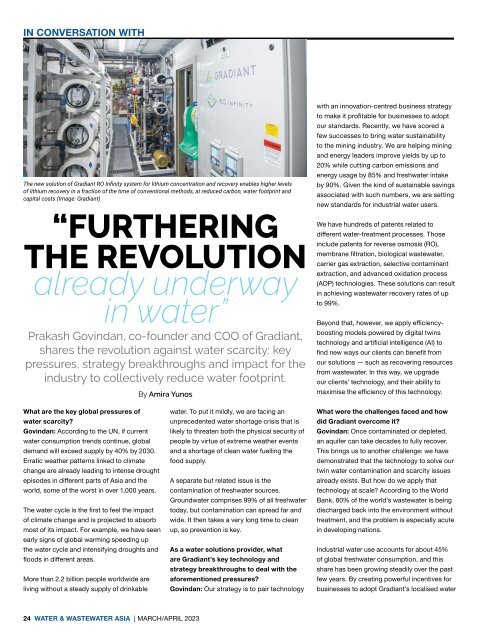Water & Wastewater Asia March/April 2023
Water & Wastewater Asia is an expert source of industry information, cementing its position as an indispensable tool for trade professionals in the water and wastewater industry. As the most reliable publication in the region, industry experts turn this premium journal for credible journalism and exclusive insight provided by fellow industry professionals. Water & Wastewater Asia incorporates the official newsletter of the Singapore Water Association (SWA).
Water & Wastewater Asia is an expert source of industry information, cementing its position as an indispensable tool for trade professionals in the water and wastewater industry. As the most reliable publication in the region, industry experts turn this premium journal for credible journalism and exclusive insight provided by fellow industry professionals. Water & Wastewater Asia incorporates the official newsletter of the Singapore Water Association (SWA).
Create successful ePaper yourself
Turn your PDF publications into a flip-book with our unique Google optimized e-Paper software.
IN CONVERSATION WITH<br />
The new solution of Gradiant RO Infinity system for lithium concentration and recovery enables higher levels<br />
of lithium recovery in a fraction of the time of conventional methods, at reduced carbon, water footprint and<br />
capital costs (Image: Gradiant)<br />
“FURTHERING<br />
THE REVOLUTION<br />
already underway<br />
in water”<br />
Prakash Govindan, co-founder and COO of Gradiant,<br />
shares the revolution against water scarcity: key<br />
pressures, strategy breakthroughs and impact for the<br />
industry to collectively reduce water footprint.<br />
By Amira Yunos<br />
with an innovation-centred business strategy<br />
to make it profitable for businesses to adopt<br />
our standards. Recently, we have scored a<br />
few successes to bring water sustainability<br />
to the mining industry. We are helping mining<br />
and energy leaders improve yields by up to<br />
20% while cutting carbon emissions and<br />
energy usage by 85% and freshwater intake<br />
by 90%. Given the kind of sustainable savings<br />
associated with such numbers, we are setting<br />
new standards for industrial water users.<br />
We have hundreds of patents related to<br />
different water-treatment processes. Those<br />
include patents for reverse osmosis (RO),<br />
membrane filtration, biological wastewater,<br />
carrier gas extraction, selective contaminant<br />
extraction, and advanced oxidation process<br />
(AOP) technologies. These solutions can result<br />
in achieving wastewater recovery rates of up<br />
to 99%.<br />
Beyond that, however, we apply efficiencyboosting<br />
models powered by digital twins<br />
technology and artificial intelligence (AI) to<br />
find new ways our clients can benefit from<br />
our solutions — such as recovering resources<br />
from wastewater. In this way, we upgrade<br />
our clients’ technology, and their ability to<br />
maximise the efficiency of this technology.<br />
What are the key global pressures of<br />
water scarcity?<br />
Govindan: According to the UN, if current<br />
water consumption trends continue, global<br />
demand will exceed supply by 40% by 2030.<br />
Erratic weather patterns linked to climate<br />
change are already leading to intense drought<br />
episodes in different parts of <strong>Asia</strong> and the<br />
world, some of the worst in over 1,000 years.<br />
The water cycle is the first to feel the impact<br />
of climate change and is projected to absorb<br />
most of its impact. For example, we have seen<br />
early signs of global warming speeding up<br />
the water cycle and intensifying droughts and<br />
floods in different areas.<br />
More than 2.2 billion people worldwide are<br />
living without a steady supply of drinkable<br />
water. To put it mildly, we are facing an<br />
unprecedented water shortage crisis that is<br />
likely to threaten both the physical security of<br />
people by virtue of extreme weather events<br />
and a shortage of clean water fuelling the<br />
food supply.<br />
A separate but related issue is the<br />
contamination of freshwater sources.<br />
Groundwater comprises 99% of all freshwater<br />
today, but contamination can spread far and<br />
wide. It then takes a very long time to clean<br />
up, so prevention is key.<br />
As a water solutions provider, what<br />
are Gradiant’s key technology and<br />
strategy breakthroughs to deal with the<br />
aforementioned pressures?<br />
Govindan: Our strategy is to pair technology<br />
What were the challenges faced and how<br />
did Gradiant overcome it?<br />
Govindan: Once contaminated or depleted,<br />
an aquifer can take decades to fully recover.<br />
This brings us to another challenge: we have<br />
demonstrated that the technology to solve our<br />
twin water contamination and scarcity issues<br />
already exists. But how do we apply that<br />
technology at scale? According to the World<br />
Bank, 80% of the world’s wastewater is being<br />
discharged back into the environment without<br />
treatment, and the problem is especially acute<br />
in developing nations.<br />
Industrial water use accounts for about 45%<br />
of global freshwater consumption, and this<br />
share has been growing steadily over the past<br />
few years. By creating powerful incentives for<br />
businesses to adopt Gradiant’s localised water<br />
24 WATER & WASTEWATER ASIA | MARCH/APRIL <strong>2023</strong>


















